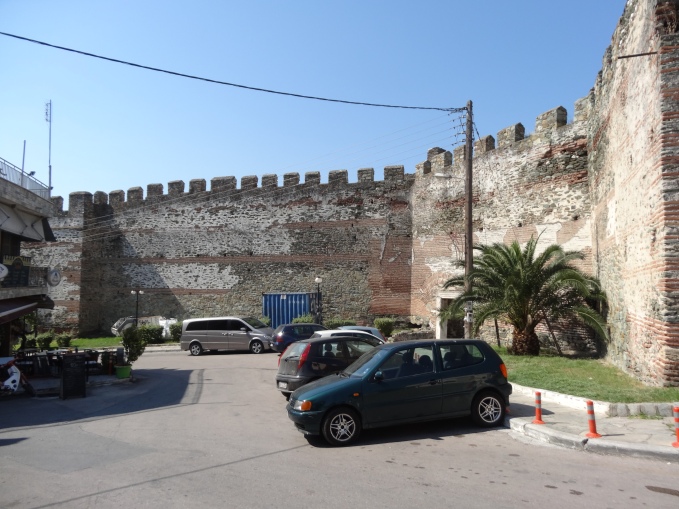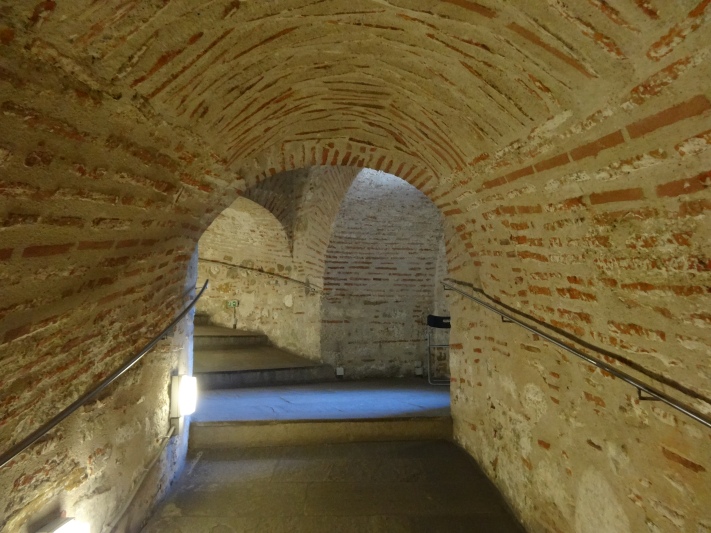After two days of walking around Thessaloniki, during which I clocked up twenty-three kilometres, I asked the receptionist if it was too far to walk to the Castles, the old upper town. She said yes, especially as it was all up hill. I opted for a taxi. I was glad I did. It was over three kilometres. The young taxi driver didn’t have much English and as I don’t have anything like enough Greek, I had some difficulty letting him know where I wanted to go, but eventually we were on the way. Very close to the top of the town we passed a fenced archaeological site. Of course I wanted to know what it was. He replied, “Is old … ah … old … is ah … old … I don’t know.” Not everyone shares my interests.
He dropped me off at “the view” as he called it, and I found that, while there was a tower with a platform in front of it from which to view the city and beyond, there was another half kilometre at least to walk up to the castle. There were impressive defensive walls enclosing the upper town, and longer walls that went around the city.
When I reached the castle, properly called the Heptapyrgion, or seven towers, I was not even surprised to see a sign on the door that said “The monument is closed this weekend for urgent restoration works.” I walked all round the outside anyway, enjoying myself immensely as I always do when pottering around old buildings.
Out the back there were a few probably Roman columns and other bits and pieces laid out in what looked like some kind of order for future work. After coming back down to “the view”, I mounted the tower and looked for a good while. It was a great view of the city, the city walls dog-legging down the hill out of sight among the buildings, and the Thermaikos Gulf.
After a cup of tea at the adjacent cafe, I took another taxi back down to the waterfront, and walked in the park where stands the modern statue of Philip II of Macedon, Alexander’s father, a brilliant leader, general and diplomat in his own right. I like the statue but my photos make it look squat, so I’ll just include the close-up of his face. It shows the wound that cost him his right eye, one of the wounds by which his remains were identified.
First the father, now for the son. I looked for the statue of Alexander, and found it right on the waterfront. It too is modern, and I had been prepared to find both it and that of Philip disappointing, but I loved it. It’s on a raised white marble dais, decorated with eight full-size Macedonian shields each paired with one of the famous seventeen foot long sarissas, and has a frieze depicting a battle at one end. The statue itself then sits atop a black marble block. It makes a beautiful tableau.
Alexander sits astride his horse, probably Bucephalus, and holds a sword in his right hand.
After hanging around vainly hoping he would come to life, I made my way to the White Tower, over thirty-three metres tall and the most recognised landmark of Thessaloniki. I was given an audio guide to help me through the museum, but it spoke in such a horrible voice and strident American accent that after listening to the story for the first exhibit, I could bear to listen to it any more, and did it the old way, looking at the pictures and reading the signage. I’d already read some of the history of the Tower, and climbed up, level by level. The shallow stair-case spirals around inside the outer wall, each level having a large round central room, some adjoining small rooms and a couple of arched window openings. They were barred.
As I climbed the stairs, I found myself becoming first slightly, then more edgy with each level. I was imagining how it must have been for the prisoners here, and the terrible suffering. I couldn’t stay in the rooms, and considered leaving, but decided to get out into the fresh air at the top. Immediately the breeze and the sunshine dissipated the oppressive feelings and I enjoyed the view. Three American women asked me to take a photo of them. I obliged, saying, “Say chickens.” They laughed and said it. I think it works better than “cheese”.






